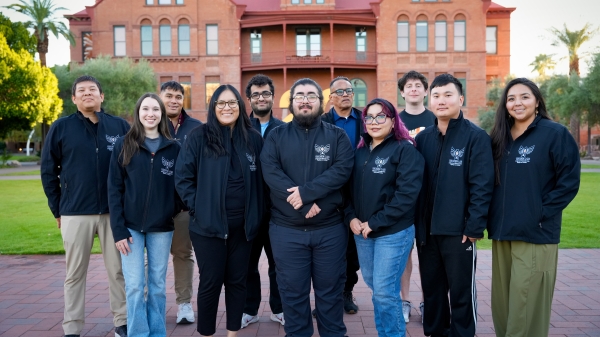$1M donation to empower lives with evidence-based psychology knowledge

Bobette Gorden and Robert Cialdini's (pictured above) latest million-dollar gift to Arizona State University is set to empower others with skills for better relationships, stress management, career success and more.
Robert Cialdini connects people to the profound insights of human social behavior, and with his latest million-dollar donation to Arizona State University, he’s ensuring an even broader audience has access to psychology knowledge to enhance their lives.
Cialdini is a Regents Professor emeritus of psychology and marketing at ASU. A member of the National Academy of Sciences, he’s globally renowned as the preeminent scholar in the field of social influence. His legacy spans more than five decades of giving back to The College of Liberal Arts and Sciences’ Department of Psychology through his groundbreaking research, philanthropy and inspiring teaching and mentoring. Now, along with Bobette Gorden, his wife and business partner, Cialdini has amplified his long-standing commitment with his gift to the department’s Psych for Life program.
“Bob and Bobette’s generous donation is yet another manifestation of their quest to give psychology away — empowering people, charitable organizations, communities and businesses to improve their overall well-being, in ways that stand true to our scientific understanding and responsible ethics,” said Foundation Professor and Psych for Life founder, Steven Neuberg.
At the heart of Psych for Life lies a powerful mission: to leverage the best science to provide people and organizations with access to evidence-based knowledge to enhance everyday life in ways that are trustworthy, engaging, usable and empowering. The initiative digitizes psychological science into on-demand, bite-sized modules, enabling individuals to acquire essential skills for enhancing various aspects of their lives. From guiding difficult conversations to building new habits and managing stress, Psych for Life utilizes top psychological science to address everyday challenges and opportunities in relationships, parenting, well-being, career and more.
“I’ve always felt a commitment to providing research-based, psychological knowledge to interested learners. I know of no program that does this better than Psych for Life,” Cialdini said.
The Psych for Life initiative began as a commitment to lifelong success and well-being for psychology students and evolved into a broader mission to support learners at scale, explained Neuberg.
“In 2017, the Department of Psychology embarked on a long-term commitment to prepare our students for the many career pathways they could be taking after graduation. We wanted to help them attain meaningful and productive lives, and began creating an integrated set of programs for enhancing undergraduate success and career preparation,” said Neuberg, the former chair of ASU’s Department of Psychology.
These programs included a psychology-specific tutoring center where students engage in a peer coaching model, an expanded internship program, increased access to scholarships for students who are typically underrepresented in STEM, and a mentorship network where alumni share their experiences of what they are currently doing with their psychology degrees. Advancing to further serve its alumni and the community, the gift from Cialdini and Gorden to Psych for Life will enable the expansion of these efforts to reach a wider range of people while also supporting the other missions of the department.
“At ASU, our work is a partnership with our communities and the world to improve lives, including economic, social and cultural health. The Psych for Life initiative is evidence that the Department of Psychology is on the forefront of developing solutions to critical social, cultural and well-being challenges,” said Tamera Schneider, professor and psychology chair.
A New York Times No. 1 bestselling author, Cialdini penned “Influence: the Psychology of Persuasion,” “Pre-suasion: a Revolutionary Way to Influence and Persuade,” and, together with Gorden, co-founded the Cialdini Institute and runs Influence at Work. They’re committed to helping causes they believe in, and Cialdini and Gorden believe in the power Psych for Life holds.
“Easy access to scientifically grounded, helpful content is exactly what we need as individuals and as a society," Gorden said, "and that’s exactly what Psych for Life offers."
More Science and technology

Indigenous geneticists build unprecedented research community at ASU
When Krystal Tsosie (Diné) was an undergraduate at Arizona State University, there were no Indigenous faculty she could look to…

Pioneering professor of cultural evolution pens essays for leading academic journals
When Robert Boyd wrote his 1985 book “Culture and the Evolutionary Process,” cultural evolution was not considered a true…

Lucy's lasting legacy: Donald Johanson reflects on the discovery of a lifetime
Fifty years ago, in the dusty hills of Hadar, Ethiopia, a young paleoanthropologist, Donald Johanson, discovered what would…